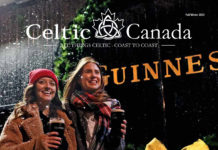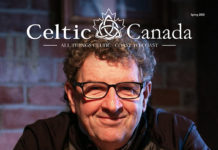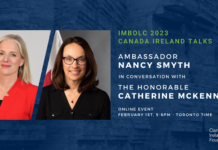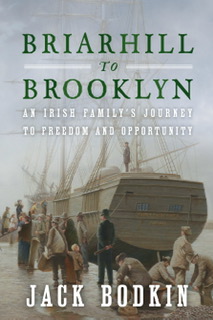An Irish family saga hits close to home
From 1845 to 1848 a mysterious potato blight devastated Ireland’s clacháns, townlands, and cities. Nearly a million died, and hundreds of thousands of Irish migrated from the Emerald Isle to begin new lives in America, Canada, Australia, or Great Britain. Many of us know the particulars of our family’s roots, but many of us don’t.
A decade ago, Jack Bodkin began researching his ancestry, and it didn’t take long before he was convinced his Bodkin family was from County Galway. He traveled to Ireland to further his research, and when he arrived at the Park House Hotel in Galway City, he gave the desk clerk his credit card and passport, and the nice young man looked up, smiling, “So, Mr. Bodkin, you’ve come all the way to Galway to claim what’s rightfully yours, have ye?”
On his trip Jack learned there were few, if any, Bodkins left in Galway, but the Bodkin banner still flies proudly in Eyre Square, along with the banners of the other thirteen Ancient Tribes of Galway.
As many of us have learned, accurate records of Irish births, deaths, and marriages in the early 1800s are difficult to locate, and Bodkin’s research quickly came to a standstill. The family tree he created stopped with his great-great-grandparents being born around 1800, and even that was based on a calculation. The dead end frustrated him, but then it got worse. No one was interested in the family tree, and he was afraid his ancestors’ story would be lost. He needed something more interesting, more memorable, to be handed down for generations to come.
Briarhill to Brooklyn, published in 2021, is a work of creative nonfiction—a novel grounded in facts—in which Bodkin tells the story of his Irish Catholic family’s journey from Briarhill, County Galway, on a coffin ship named Cushlamachree. The family—John and Eleanor Bodkin, and seven children—began their journey on Saint Patrick’s Day, 1848.
Was it the prospect of starvation, or the fear of typhus that drove the family from Galway onto that Irish coffin ship? Their dream was American freedom and opportunity and the Cushlamachree’s destination was Brooklyn.
An unimaginable hurdle confronted the seven young Bodkin siblings, only days after docking in New York. But they managed to survive into adulthood as they were led by their two oldest brothers—Dominic and Martin.
The prologue to Briarhill to Brooklyn sets the stage for the immigrants’ famine-era story, using the retrospective voice of Martin, the first-person narrator:
“Nine of us crowded around the table, and as usual, Mam had boiled a potful of lumpers with turnips and butter from a neighbor’s cow. ‘We might not starve to death, John, but the fever will surely get us.’ The finality in her voice tore at me. Me brothers and sisters, those who were old enough to comprehend her words, looked stunned. I knew Mam was right. She usually was.
Later that night, Da said that he wanted me to walk to Galway City with him in the morning to see Uncle Laurence. Uncle was the Catholic bishop of Galway, and Da said he needed to talk to him before we could go to America. Was Da going to ask for his approval for the family to leave Ireland? Was he just going to tell him we were leaving for America? I wasn’t sure, but I was over the moon that Da had asked me to walk with him. He had chosen me instead of Dominic.
At the bottom of the Bohermore, we walked through a muddy parcel of land. It was all that remained of Galway’s ancient city gates. Peasants overflowed the space, large families like our own crowding around small fires. We entered Galway City and passed hundreds more peasants of all generations, waiting in a soup line which wound along the grey cobblestones of William Street. Families waiting for hours to get a cup of watery soup made with some meat and vegetables—and if they were fortunate, they collected a small sack of cornmeal to be boiled into some liquid mush.
Da put his big hand on me shoulder, and mine was around his hip, as we walked past a family huddled in front of a shop. The mother and father wept over the body of their son. His young brothers and sisters held each other, standing silently by their parents. I didn’t want to look—but I did—and found the face of the dead boy. He might have been the same age as me, but it was hard to tell. His sunken cheeks, spindly limbs, and swollen belly made reckoning his years difficult. The lad’s dark eyes were frightening, as was the soft downy hair that had grown on his face while he starved.
‘Don’t look, Martin,’ Da almost whispered as he guided me away. …”
As Bodkin’s story unfolds, in the decades following the family’s arrival in Brooklyn, the siblings assimilate into New York’s melting pot; Dominic becomes a fledgling surgeon on the battlefields of the American Civil War and spends the next thirty-five years delivering and caring for thousands of Brooklyn babies; and Martin—a Civil War veteran himself—becomes the progenitor of a large family of New York Bodkins.
The tale Bodkin tells is a success story—an Irish immigrant family’s success story—familiar to us all.
Jack Bodkin is a retired certified public accountant. Briarhill to Brooklyn is his first book.
He was born in Brooklyn in 1947, and for the first two years of his life his family lived in the neighborhood where his ancestors thrived.
In 1950 the family moved to the post-World War II community of Merrick, Long Island. After graduating from Chaminade High School and Wheeling College, he returned to Long Island and worked in New York City until 1977. He lives in Wheeling, West Virginia with his wife, Christine.
In 1950 the family moved to the post–World War II community of Merrick, Long Island.
Briarhill to Brooklyn is available in paperback, hardcover, and eBook at amazon.com or through briarhilltobrooklyn.com.









































